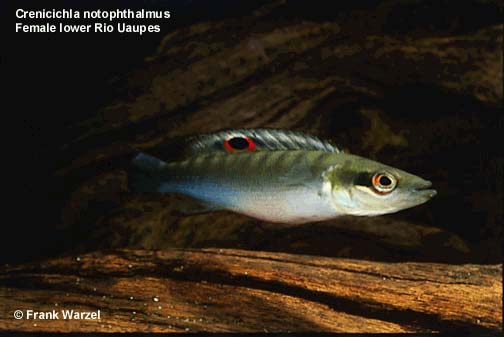| Home | Pikes | Neotropicals | Collecting | Photography | Personal | Links | Site map |

Crenicichla notophthalmus Regan, 1913
Group: Wallaci
Distribution: Rio Negro and adjoining black water bodies.
Type Locality: Amazon River at Manaus, Brazil
Size: 3-4 inches
Comments: This is a frequently encountered species in Rio Negro and its tributaries, living very close to the shores of rivers, streams and lakes. This fish occupies leaf litter zones and shares its habitat with many Apistogramma species. It is considered a blackwater species with pH in its native habitat occasionally dropping below 4.0 but my observations and measurements have been near 5. Hardness of the water is usually been undetectable in many blackwater systems. Somehow, these nutrient poor water systems seem to support a rich variety of aquatic life. I have often found Hoplias sp. and Acaronia nassa along with this fish in the leaf litter, presumably acting as predators to those that live within. Leaf litter certainly offers some protection from some predators but life is meager and finding scarce food is a challenge. C. notophthalmus is considered a micropredator, feeding on small invertebrates and fishes. I have not read reports of stomach content analysis of this species but juvenile Apistogramma are likely to be a source of nutrition as they are always found together.
 It is easy to distinguish adults of this species from C. regani another similar species with a much wider distribution and variation, by focusing on the dorsal fin. The first 3-5 doesal fin rays in male C. notophthalmus are unattached, free-standing and much longer than the other rays. Females have dorsal fin ocelli like C. regani but the number of spots in C. notophthalmus is usually one (occasionally two) where as C. regani females have a very varied number of patters and spots. The spots are always black in both species but the ring aroung the black spot is usually white in C. regani and red in C. notophthalmus.
It is easy to distinguish adults of this species from C. regani another similar species with a much wider distribution and variation, by focusing on the dorsal fin. The first 3-5 doesal fin rays in male C. notophthalmus are unattached, free-standing and much longer than the other rays. Females have dorsal fin ocelli like C. regani but the number of spots in C. notophthalmus is usually one (occasionally two) where as C. regani females have a very varied number of patters and spots. The spots are always black in both species but the ring aroung the black spot is usually white in C. regani and red in C. notophthalmus.
This fish is easy to keep and feed in aquaria and after a territory has been established by a pair, they seldom wander out. I was surprised that I could house two pairs in a 60-gal (4-foot long) aquarium with minimal damage to each other. I, and many others I know, have tried in vain to spawn this species but it has revealed its secrets only to a handful of breeders worldwide. I've been told that low ph (think 4 to 5) and undetectable hardness with high temperatures and lots of live foods do the trick.
Described in: Annals and Magazine of Natural History (8) 11; p 502-503
| Back to ==> Home / Pike Photos / C. notophthalmus |
| Home | Pikes | Neotropicals | Collecting | Photography | Personal | Links | Site map |

|
http://geocities.datacellar.net/NapaValley/5491
Latest update: 21 July 1999 Comments on this page: E-Mail author |